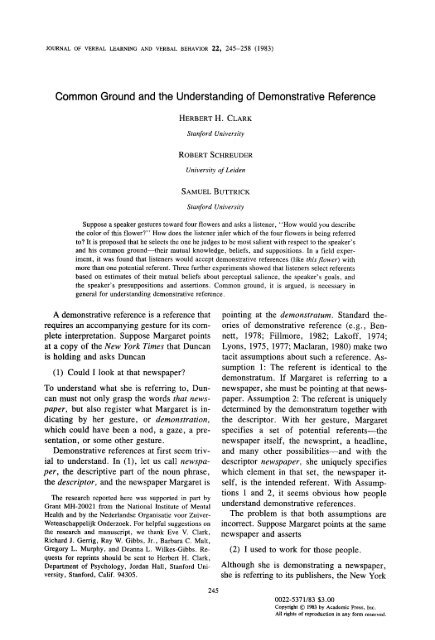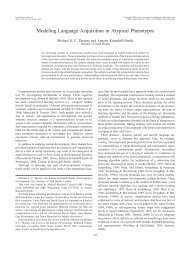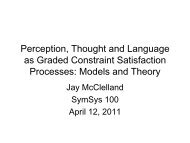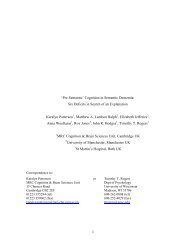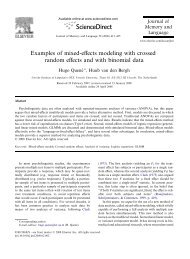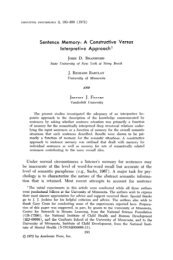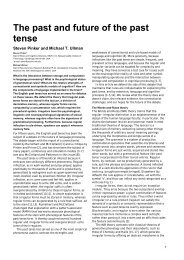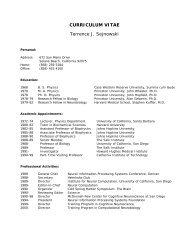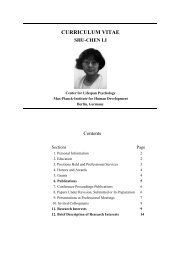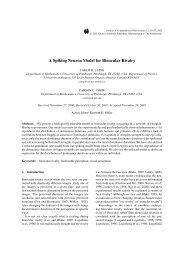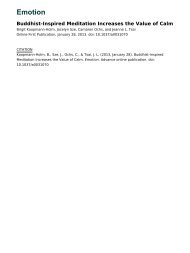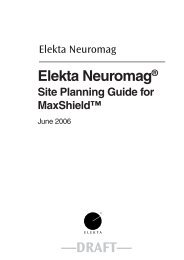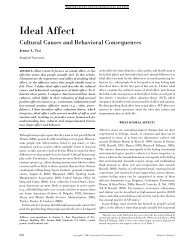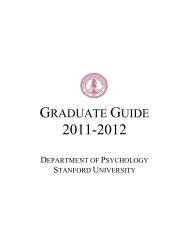Common Ground and the Understanding of Demonstrative Reference
Common Ground and the Understanding of Demonstrative Reference
Common Ground and the Understanding of Demonstrative Reference
You also want an ePaper? Increase the reach of your titles
YUMPU automatically turns print PDFs into web optimized ePapers that Google loves.
JOURNAL OF VERBAL LEARNING AND VERBAL BEHAVIOR 22, 245--258 (1983)<strong>Common</strong> <strong>Ground</strong> <strong>and</strong> <strong>the</strong> Underst<strong>and</strong>ing <strong>of</strong> <strong>Demonstrative</strong> <strong>Reference</strong>HERBERT H. CLARKStanford Universi~ROBERT SCHREUDERUniversi~ ~Lei~nSAMUEL BUTTRICKStanford UniversitySuppose a speaker gestures toward four flowers <strong>and</strong> asks a listener, "How would you describe<strong>the</strong> color <strong>of</strong> this flower?" How does <strong>the</strong> listener infer which <strong>of</strong> <strong>the</strong> four flowers is being referredto? It is proposed that he selects <strong>the</strong> one he judges to be most salient with respect to <strong>the</strong> speaker's<strong>and</strong> his common ground--<strong>the</strong>ir mutual knowledge, beliefs, <strong>and</strong> suppositions. In a field experiment,it was found that listeners would accept demonstrative references (like this flower) withmore than one potential referent. Three fur<strong>the</strong>r experiments showed that listeners select referentsbased on estimates <strong>of</strong> <strong>the</strong>ir mutual beliefs about perceptual salience, <strong>the</strong> speaker's goals, <strong>and</strong><strong>the</strong> speaker's presuppositions <strong>and</strong> assertions. <strong>Common</strong> ground, it is argued, is necessary ingeneral for underst<strong>and</strong>ing demonstrative reference.A demonstrative reference is a reference thatrequires an accompanying gesture for its completeinterpretation. Suppose Margaret pointsat a copy <strong>of</strong> <strong>the</strong> New York Times that Duncanis holding <strong>and</strong> asks Duncan(1) Could I look at that newspaper?To underst<strong>and</strong> what she is referring to, Duncanmust not only grasp <strong>the</strong> words that newspaper,but also register what Margaret is indicatingby her gesture, or demonstration,which could have been a nod, a gaze, a presentation,or some o<strong>the</strong>r gesture.<strong>Demonstrative</strong> references at first seem trivialto underst<strong>and</strong>. In (1), let us call newspaper,<strong>the</strong> descriptive part <strong>of</strong> <strong>the</strong> noun phrase,<strong>the</strong> descriptor, <strong>and</strong> <strong>the</strong> newspaper Margaret isThe research reported here was supported in part byGrant MH-20021 from <strong>the</strong> National Institute <strong>of</strong> MentalHealth <strong>and</strong> by <strong>the</strong> Nederl<strong>and</strong>se Organisatie voor Zuiver-Wetenschappelijk Onderzoek. For helpful suggestions on<strong>the</strong> research <strong>and</strong> manuscript, we thank Eve V. Clark,Richard J. Gerrig, Ray W. Gibbs, Jr., Barbara C. Malt,Gregory L. Murphy, <strong>and</strong> Deanna L. Wilkes-Gibbs. Requestsfor reprints should be sent to Herbert H. Clark,Department <strong>of</strong> Psychology, Jordan Hall, Stanford University,Stanford, Calif. 94305.245pointing at <strong>the</strong> demonstratum. St<strong>and</strong>ard <strong>the</strong>ories<strong>of</strong> demonstrative reference (e.g., Bennett,1978; Fillmore, 1982; Lak<strong>of</strong>f, 1974;Lyons, 1975, 1977; Maclaran, 1980) make twotacit assumptions about such a reference. Assumption1: The referent is identical to <strong>the</strong>demonstratum. If Margaret is referring to anewspaper, she must be pointing at that newspaper.Assumption 2: The referent is uniquelydetermined by <strong>the</strong> demonstratum toge<strong>the</strong>r with<strong>the</strong> descriptor. With her gesture, Margaretspecifies a set <strong>of</strong> potential referents--<strong>the</strong>newspaper itself, <strong>the</strong> newsprint, a headline,<strong>and</strong> many o<strong>the</strong>r possibilities--<strong>and</strong> with <strong>the</strong>descriptor newspaper, she uniquely specifieswhich element in that set, <strong>the</strong> newspaper itself,is <strong>the</strong> intended referent. With Assumptions1 <strong>and</strong> 2, it seems obvious how peopleunderst<strong>and</strong> demonstrative references.The problem is that both assumptions areincorrect. Suppose Margaret points at <strong>the</strong> samenewspaper <strong>and</strong> asserts(2) I used to work for those people.Although she is demonstrating a newspaper,she is referring to its publishers, <strong>the</strong> New York0022-5371/83 $3.00Copyright © 1983 by Academic Press, Inc.All rights <strong>of</strong> reproduction in any form reserved.
DEMONSTRATIVE REFERENCE 247nically <strong>the</strong> mutual knowledge, beliefs, <strong>and</strong> assumptionsshared by <strong>the</strong> speaker <strong>and</strong> addressees(see Clark & Carlson, 1981; Clark & Marshall,1981). In our proposal, <strong>the</strong> speaker intendseach addressee to base his inferencesnot on just any knowledge or beliefs he mayhave, but only on <strong>the</strong>ir mutual knowledge orbeliefs--<strong>the</strong>ir common ground. One goal <strong>of</strong>our research is to explore <strong>the</strong> role commonground plays in demonstrative reference.Underdetermined <strong>Demonstrative</strong> <strong>Reference</strong>Let us turn now to underdetermined demonstrativereference. Suppose Julia nods ata cluster <strong>of</strong> men jogging along a road <strong>and</strong> tellsKen(4) That man is my neighbor.If Ken takes d to be <strong>the</strong> set <strong>of</strong> ten men, <strong>and</strong>r to be one <strong>of</strong> <strong>the</strong>m, what F should he infer?If one jogger was naked, he might infer F tobe naked-man-in. If exactly one jogger wasespecially tall, a midget, or in a gorilla suit,or if one had just fallen, won <strong>the</strong> race, orslugged a byst<strong>and</strong>er, he would infer a differentF <strong>and</strong> r. In each case, he would choose Fto make r <strong>the</strong> most distinctive man in <strong>the</strong> cluster.The F would have <strong>the</strong> general form mostsalient-part-<strong>of</strong>.This characterization, however, cannot becomplete. Each jogger is <strong>the</strong> most salient bysome criterion--by being <strong>the</strong> only one withred hair, in second place, or wearing bluesocks. In what respect is <strong>the</strong> intended referentmost salient? Suppose Julia had just told Kenthat her neighbor was completely bald, <strong>and</strong>suppose all <strong>the</strong> joggers except one were hirsute.In saying (4), Julia would expect Ken tosee that this prior information, part <strong>of</strong> <strong>the</strong>ircommon ground, was relevant. He was to pick<strong>the</strong> jogger most salient not on general grounds,but against <strong>the</strong>ir particular common ground.He was to select <strong>the</strong> bald man even if <strong>the</strong>tallest man, <strong>the</strong> midget, or <strong>the</strong> winner wouldbe most salient on general grounds. As <strong>the</strong>principle <strong>of</strong> optimal design dictates, <strong>the</strong> onlyinformation he should consult is <strong>the</strong>ir commonground. So <strong>the</strong> general form <strong>of</strong> F shouldbe most-salient-part-<strong>of</strong>-with-respect-to-common-ground.The common ground between two people isbased on roughly three sources <strong>of</strong> information(Clark & Marshall, 1981). The first is perceptualevidence, what <strong>the</strong> two have jointlyexperienced or are jointly experiencing at <strong>the</strong>moment. The second is linguistic evidence,what <strong>the</strong> two have jointly heard said or arenow jointly hearing as participants in <strong>the</strong> sameconversation. The third is community membership.They take as common ground everything<strong>the</strong>y believe is universally, or almostuniversally, known, believed, or supposed in<strong>the</strong> many communities <strong>and</strong> subcommunities towhich <strong>the</strong>y mutually believe <strong>the</strong>y both belong.Most parts <strong>of</strong> common ground are basedon a combination <strong>of</strong> <strong>the</strong>se sources.Two people's common ground may be a tinyplot or a large acreage. If Julia <strong>and</strong> Ken arestrangers, <strong>the</strong>ir common ground comes entirelyfrom <strong>the</strong>ir joint membership in <strong>the</strong> community<strong>of</strong>, say, adult Americans (mutuallyrecognized from <strong>the</strong>ir American accents) <strong>and</strong>from <strong>the</strong> scene <strong>the</strong>y are witnessing. If Juliaassumed nakedness would be <strong>the</strong> most salientattribute in <strong>the</strong> scene for most Americans, shewould expect Ken to underst<strong>and</strong> her in (4) asreferring to <strong>the</strong> naked jogger. But if Julia <strong>and</strong>Ken are intimates, <strong>the</strong>ir common ground willbe extensive <strong>and</strong> include <strong>the</strong>ir discussion <strong>of</strong>her bald neighbor, <strong>and</strong> Ken should underst<strong>and</strong>her as referring to <strong>the</strong> jogger who is bald. For<strong>the</strong> same demonstratum <strong>and</strong> descriptor, <strong>the</strong> relationF, <strong>and</strong> hence <strong>the</strong> referent r, shouldchange with common ground.At first, one might view <strong>the</strong> underdetermineddemonstrative references in (2) through(4) simply as defective, as no different from<strong>the</strong> equivalent underdetermined definite descriptions.If <strong>the</strong>y were, <strong>the</strong>y should be replaceableby underdetermined definite descriptionswith no change in underst<strong>and</strong>ability.They are not. Suppose Margaret uttered (1')through (4') in <strong>the</strong> same contexts as (1) through(4), but without <strong>the</strong> accompanying gestures.(1 ') Could I see <strong>the</strong> newspaper in your h<strong>and</strong>?(2') *I used to work for <strong>the</strong> people in yourh<strong>and</strong>.(3') *Could I see <strong>the</strong> newspaper in yourh<strong>and</strong>?
248 CLARK, SCHREUDER, AND BUTTRICK(4') *The man in <strong>the</strong> group in front <strong>of</strong> usis my neighbor.While most people we have asked find (1')acceptable, <strong>the</strong>y find (2') through (4') unpalatable.They feel as if <strong>the</strong>y are left with <strong>the</strong>questions "What people? .... Which newspaper?"<strong>and</strong> "Which man?" whereas <strong>the</strong>y accept(2) through (4) without such questions.When a reference is accompanied by a demonstration,listeners seem to feel <strong>the</strong>y are tounderst<strong>and</strong> it partly by examining <strong>the</strong> demonstratummore closely. <strong>Demonstrative</strong> referencesare simply different from o<strong>the</strong>r definitedescriptions (Hawkins, 1978).Before examining this common groundmodel fur<strong>the</strong>r, we need to demonstrate thatAssumption 2 is false--that people will acceptdemonstrative references with more thanone potential referent. That was <strong>the</strong> aim <strong>of</strong>Experiment 1.EXPERIMENT 1We stopped students on <strong>the</strong> Stanford Universitycampus, showed <strong>the</strong>m a photographwith four types <strong>of</strong> flowers in it, <strong>and</strong> asked,gesturing to <strong>the</strong> photograph as a whole, "Howwould you describe <strong>the</strong> color <strong>of</strong> this flower?"We expected <strong>the</strong>m to respond in one <strong>of</strong> threemain ways:(a) Implicit acknowledgement <strong>of</strong> underst<strong>and</strong>ing,"It's yellow."(b) Request for confirmation, "Do youmean this flower [pointing at one <strong>of</strong> <strong>the</strong>flowers]?"(c) Request for clarification, "Which flowerdo you mean?"Response (a) indicates <strong>the</strong> students thought<strong>the</strong>y understood <strong>the</strong> reference; (b) indicatesless certainty; (c) indicates <strong>the</strong> least certainty,since <strong>the</strong> students do not even <strong>of</strong>fer <strong>the</strong> conjecture<strong>the</strong>y do in (b). Put negatively, (b) indicates<strong>the</strong>y thought <strong>the</strong> reference was partlydefective, <strong>and</strong> (c), ra<strong>the</strong>r more defective. With(a), (b), <strong>and</strong> (c), we have a natural scale <strong>of</strong>underst<strong>and</strong>ability.MethodThe color photograph we used, from <strong>the</strong>Sunset New Western Garden book (1979, p.128), depicted four varieties <strong>of</strong> flowers besidea wooden fence: a cluster <strong>of</strong> yellow daffodilsin <strong>the</strong> front center; white daisies dispersedthroughout <strong>the</strong> background; a number <strong>of</strong> orangeCalifornia poppies at <strong>the</strong> right; <strong>and</strong> acluster <strong>of</strong> blue irises on <strong>the</strong> far left. We comparedtwo versions <strong>of</strong> <strong>the</strong> photograph. Picture1 was a color Xerox copy <strong>of</strong> <strong>the</strong> photograph,measuring 18 by 24 cm, in which <strong>the</strong> daffodilswere only slightly more prominent than <strong>the</strong>o<strong>the</strong>r three flowers. Picture 2 was a secondcolor Xerox copy, cropped to 11 by 15 cm,in which <strong>the</strong> daffodils were clearly more salientthan <strong>the</strong> o<strong>the</strong>rs. The two pictures eachshowed all four types <strong>of</strong> flowers but differedin <strong>the</strong> prominence <strong>of</strong> <strong>the</strong> daffodils.One <strong>of</strong> us, Buttrick, approached 40 studentsat various places on <strong>the</strong> Stanford Universitycampus. With a clipboard in h<strong>and</strong>, heintroduced himself to each student, h<strong>and</strong>ed <strong>the</strong>student one <strong>of</strong> <strong>the</strong> two pictures, <strong>and</strong>, noddingat <strong>the</strong> picture while preparing to write down<strong>the</strong> answer, asked, "How would you describe<strong>the</strong> color <strong>of</strong>~this flower?" He wrote downeverything <strong>the</strong> student said, including all requestsfor confirmation or clarification. Theflower chosen was always clear from <strong>the</strong> colornamed or flower pointed at. Each picture wasdescribed by 20 students.Results <strong>and</strong> DiscussionSuppose that listeners look where <strong>the</strong> speakeris pointing, note <strong>the</strong> set <strong>of</strong> potential referents<strong>the</strong>re (<strong>the</strong> referent array), <strong>and</strong> select <strong>the</strong> objectuniquely specified by <strong>the</strong> descriptor. Thismodel, which is much like Olson's (1970)model <strong>of</strong> definite reference, is based on Assumptions1 <strong>and</strong> 2. We will call it <strong>the</strong> classicalmodel. According to that model, if <strong>the</strong>referent array contains four flowers, listenersshould accept a descriptor like daffodil, whichpicks out a unique flower, but <strong>the</strong>y should notaccept flower, which does not. Yet as shownin Table 1, many students in Experiment 1accepted flower without hesitation. For Picture2, 11 <strong>of</strong> 20 students immediately described<strong>the</strong> color <strong>of</strong> <strong>the</strong> daffodils. For <strong>the</strong> twopictures toge<strong>the</strong>r, 14 <strong>of</strong> 40 students did so. Toanticipate a finding in Experiment 4, 12 <strong>of</strong> 15students gave response (a) for a similar pic-
250 CLARK, SCHREUDER, AND BUTTRICKcommon ground with <strong>the</strong> anonymous student.If she takes this as a "unique signal" for coordinating<strong>the</strong>ir expectations, she will pick <strong>the</strong>basketball. Let us call such a choice on aSchelling task a Schelling choice.But suppose Mary is told her partner is Peter,with whom she regularly plays squash.Because she could assume <strong>the</strong> squash ball wasparticularly salient in <strong>the</strong>ir common ground,she could select it, believing Peter too wouldsee it as a "unique signal" for coordinatingexpectations. No matter how avid a squashplayer she was, she could not make <strong>the</strong> sameassumption when her partner was just "ano<strong>the</strong>rstudent." It matters to Mary who herpartner is because it matters what is in <strong>the</strong>ircommon ground.Schelling choices, <strong>the</strong>refore, should reflectwhat <strong>the</strong> two partners take to be salient withrespect to <strong>the</strong>ir common ground. In <strong>the</strong> commonground model, listeners choose referentsby <strong>the</strong> same criterion--salience with respectto common ground--<strong>and</strong> so <strong>the</strong> distribution<strong>of</strong> Schelling choices should predict <strong>the</strong>irchoices <strong>of</strong> referents. It should also predict <strong>the</strong>irconfidence. In a Schelling task, if object A isselected more <strong>of</strong>ten than object B, <strong>the</strong>n in <strong>the</strong>corresponding reference task those listenerswho happen to select A should be more confidentthan those who happen to select B. Experiments2 <strong>and</strong> 3 were designed to test <strong>the</strong>sepredictions.EXPERIMENT 2Students were asked to interpret demonstrativereferences from a speaker <strong>the</strong>y did notknow. In assessing common ground, <strong>the</strong>refore,<strong>the</strong>y could make only <strong>the</strong> most generalassumptions about <strong>the</strong> display <strong>and</strong> how it wouldbe viewed by most people. In fact, peoplegenerally have a pretty good idea <strong>of</strong> what o<strong>the</strong>rswill attend to in such a display, especiallywhat <strong>the</strong>y will see as salient, distinctive, orout <strong>of</strong> place. These estimates should be <strong>the</strong>same ones <strong>the</strong>y use in making Schelling choices<strong>and</strong>, more simply, in choosing <strong>the</strong> most salientobject.MethodWe constructed 27 displays <strong>of</strong> common objectsby cutting pictures out <strong>of</strong> merch<strong>and</strong>isecatalogs from such department stores as Sears,J. C. Penney, <strong>and</strong> Best Products. Each displaydepicted two to seven objects <strong>of</strong> <strong>the</strong> sametype, like four watches, six lamps, or threetents, each with a number or letter next to itfor identification. The displays was designedso that one object in each display seemed moreprominent than <strong>the</strong> rest--larger, more distinctivein shape, more foregrounded--<strong>and</strong> so that<strong>the</strong> prominence <strong>of</strong> <strong>the</strong> most prominent objectvaried from display to display. The 27 displayswere placed in one order <strong>and</strong> photocopiedto make three booklets that differed onlyin <strong>the</strong> sentence typed at <strong>the</strong> bottom <strong>of</strong> eachpage: "What do you think <strong>of</strong> this X" for areference task, "You are both to choose <strong>the</strong>same X" for a Schelling task, <strong>and</strong> "You areto choose <strong>the</strong> most prominent or salient X"for a salience task. For X we substituted aone- or two-word description <strong>of</strong> <strong>the</strong> objects in<strong>the</strong> picture--for example, watch, lamp, or tent.<strong>Reference</strong> task. Ten students were instructed,"Imagine that you <strong>and</strong> ano<strong>the</strong>r personare looking through this catalog. He showsyou this page <strong>and</strong> asks you <strong>the</strong> question printedat <strong>the</strong> bottom (for example, 'What do you think<strong>of</strong> this alarm clock?'). You are to indicatefor each display which object you thinkhe is referring to. After you have made yourchoice, please indicate how confident you arethat you have chosen <strong>the</strong> correct referent."They rated <strong>the</strong>ir confidence on a 7-point scale,with 1 meaning "no confidence" <strong>and</strong> 7 "veryconfident."After <strong>the</strong> students had finished, <strong>the</strong>y wereasked to go through <strong>the</strong> displays again <strong>and</strong>rank <strong>the</strong> remaining objects for how likely eachone was to be <strong>the</strong> intended referent. They were<strong>the</strong>n asked to describe for each display <strong>the</strong>criteria on which <strong>the</strong>y had based <strong>the</strong>ir initialchoices. Since <strong>the</strong> reference choices <strong>and</strong> confidenceratings were collected first, <strong>the</strong>y couldnot be influenced by <strong>the</strong> later judgments.Schelling task. Ten o<strong>the</strong>r students were instructed,"Imagine that you <strong>and</strong> ano<strong>the</strong>r personwhom you do not know are looking at<strong>the</strong>se displays. If you can both independentlyselect <strong>the</strong> same object, you will win a prize.If you fail to choose <strong>the</strong> same object <strong>the</strong>n youlose." O<strong>the</strong>rwise, <strong>the</strong>y followed <strong>the</strong> same
DEMONSTRATIVE REFERENCE 251procedure as in <strong>the</strong> reference task. They wentthrough <strong>the</strong> 27 displays one time makingchoices <strong>and</strong> confidence ratings, a second timeranking <strong>the</strong> remaining objects, <strong>and</strong> a third timedescribing <strong>the</strong> criteria for <strong>the</strong>ir choices.Salience task. Ten more students were askedto choose for each display "<strong>the</strong> most prominentor salient X." They too went through <strong>the</strong>displays three times, once making choices <strong>and</strong>salience ratings, a second time giving ranks,<strong>and</strong> a third time describing <strong>the</strong>ir criteria.The 30 students were Stanford Universityundergraduates participating ei<strong>the</strong>r as a courserequirement or for pay. They worked in groups<strong>of</strong> two to four in sessions lasting about 45minutes. The first three displays were consideredpractice <strong>and</strong> later discarded.ResultsThe choices in <strong>the</strong> reference task generallycoincided with those in <strong>the</strong> Schelling <strong>and</strong> saliencetasks• In each display for each task, oneobject tended to be chosen more than any o<strong>the</strong>r.Let us call this <strong>the</strong> major choice. In <strong>the</strong> referencetask, <strong>the</strong> percentage <strong>of</strong> students making<strong>the</strong> major choice averaged 70% (rangingfrom 40 to 100%). The percentages in <strong>the</strong>Schelling <strong>and</strong> salience tasks averaged 81 <strong>and</strong>89%, respectively• So within tasks, <strong>the</strong> studentsshowed considerable agreement. Themajor choices also tended to coincide acrosstasks. For 18 <strong>of</strong> <strong>the</strong> 24 displays, <strong>the</strong>y wereidentical for <strong>the</strong> three tasks; for all 24 displays,<strong>the</strong>y were identical for at least two <strong>of</strong><strong>the</strong> three tasks• For each display we can identify<strong>the</strong> one object on which <strong>the</strong> largest number<strong>of</strong> students agreed across all three tasks.The percentage <strong>of</strong> students making that choiceaveraged 67%, which is near <strong>the</strong> maximumpossible <strong>of</strong> 70%, <strong>the</strong> average percentage <strong>of</strong>students making <strong>the</strong> major choice on <strong>the</strong> ref-erence task. So <strong>the</strong> major choices in <strong>the</strong> threetasks are in good agreement.A second way to show agreement across <strong>the</strong>three tasks is to compare <strong>the</strong> rankings <strong>of</strong> <strong>the</strong>objects in each display. For each task, wecomputed <strong>the</strong> mean ranks for <strong>the</strong> two to sevenobjects in each display; we <strong>the</strong>n correlated <strong>the</strong>mean ranks, for each display separately, between<strong>the</strong> reference <strong>and</strong> Schelling tasks, between<strong>the</strong> reference <strong>and</strong> salience tasks, <strong>and</strong>between <strong>the</strong> Schelling <strong>and</strong> salience tasks• These72 correlations (3 comparisons for 24 displays)had a mean <strong>of</strong> .81 <strong>and</strong> a median <strong>of</strong> .85.Table 2 shows <strong>the</strong> means, medians, <strong>and</strong> ranges<strong>of</strong> <strong>the</strong>se correlations for <strong>the</strong> three comparisonsseparately. The mean correlations for <strong>the</strong> threecomparisons were very similar, ranging from• 80 to. 84, as were <strong>the</strong> medians, which rangedfrom .83 to .89. So this measure, too, is inline with <strong>the</strong> common ground model: <strong>the</strong>choices in <strong>the</strong> reference, Schetling, <strong>and</strong> saliencetasks were very similar.The students in Experiment 2, as in Experiment1, ranged widely on most displays inhow confident <strong>the</strong>y were in <strong>the</strong>ir initial choices,from 1 ("no confidence") to 7 ("very confident").These ratings yielded a surprisingfinding: <strong>the</strong> more popular a given choice turnedout to be--without anyone knowing this, <strong>of</strong>course--<strong>the</strong> more confident were <strong>the</strong> peoplewho had made it.There are several ways <strong>of</strong> demonstrating this.Consider <strong>the</strong> reference task. For each display,we can compare <strong>the</strong> mean confidence on <strong>the</strong>major choice with <strong>the</strong> mean confidence on <strong>the</strong>o<strong>the</strong>r choices. For <strong>the</strong> 17 displays where wecould compute both means, <strong>the</strong> majority choiceaveraged 4.6 (on <strong>the</strong> 7-point scale) <strong>and</strong><strong>the</strong> o<strong>the</strong>r choices averaged only 3.6, minF'(1,19) = 5.19, p < .05 (see Clark, 1973)•The corresponding two means for <strong>the</strong> Schell-TABLE 2MEANS, MEDIANS, AND RANGES OF THE 24 CORRELATIONS COMPUTED ON THE MEAN RANKS OF THE STUDENTS' CHOICESBETWEEN THE REFERENCE, SCHELLING, AND SALIENCE TASKS (EXPERIMENT 2)Pairs <strong>of</strong> tasks Mean Median Range<strong>Reference</strong> <strong>and</strong> Schelling tasks .80 .89 0.33-1.00<strong>Reference</strong> <strong>and</strong> salience tasks .80 .83 0.27-1.00Schelling <strong>and</strong> salience tasks .84 .89 0.21-1.00
252 CLARK, SCHREUDER, AND BUTTRICKing task were 5.0 <strong>and</strong> 3.9, min F'(1,23) =15.20, p < .01, <strong>and</strong> for <strong>the</strong> salience task, 6.1<strong>and</strong> 5.2, min F'(1,15) = 7.37, p < .025.The same point can be illustrated in ano<strong>the</strong>rway. For each task, we classified each student'schoice on each array by how many <strong>of</strong><strong>the</strong> ten students concurred on that choice, <strong>and</strong><strong>the</strong>n computed <strong>the</strong> mean confidence rating <strong>of</strong>each <strong>of</strong> <strong>the</strong>se ten categories (1 to 10 studentsconcurring on <strong>the</strong> choice). In <strong>the</strong> referencetask, for example, <strong>the</strong>re were four separatedisplays in which eight students agreed on asingle object within <strong>the</strong> display. These 32confidence ratings averaged 5.2. The ten meanratings computed this way for each task areplotted in Figure 1.In all three tasks, <strong>the</strong> more students whoconcurred on a choice, <strong>the</strong> more confident were<strong>the</strong> students who made that choice. In <strong>the</strong> reference,Schelling, <strong>and</strong> salience tasks, <strong>the</strong> meancorrelations were .79, .91, <strong>and</strong> .92, respectively.These three coefficients are each significantlygreater than zero, F(1,9) > 14.94,p < .01, <strong>and</strong> <strong>the</strong>y are not significantly differentfrom one ano<strong>the</strong>r. Figure 1 also shows,for <strong>the</strong> major Schelling choices only, <strong>the</strong> meanconfidence ratings from <strong>the</strong> reference taskas predicted from <strong>the</strong> number <strong>of</strong> studentsconcurring on <strong>the</strong>ir Schelling choices. Thecorrelation here, despite a restricted range,was .75.Although <strong>the</strong> three tasks should be verysimilar to each o<strong>the</strong>r, <strong>the</strong> salience task shouldst<strong>and</strong> out in one respect. In <strong>the</strong> reference <strong>and</strong>Schelling tasks, <strong>the</strong> students rated <strong>the</strong>ir confidencein whe<strong>the</strong>r <strong>the</strong>ir choice would be <strong>the</strong>same as <strong>the</strong> choice <strong>of</strong> ano<strong>the</strong>r person, someone<strong>the</strong>y did not know. But in <strong>the</strong> saliencetask, <strong>the</strong>y rated <strong>the</strong> salience as <strong>the</strong>y alonejudged it, without any implied comparison withano<strong>the</strong>r person's judgments. So <strong>the</strong> studentsin <strong>the</strong> reference <strong>and</strong> Schelling tasks should beless confident that <strong>the</strong>y knew what o<strong>the</strong>r peoplewould do than <strong>the</strong> students in <strong>the</strong> saliencetask should be in what <strong>the</strong>y <strong>the</strong>mselves thought.Indeed, for <strong>the</strong> reference <strong>and</strong> Schelling tasks,REFERENCESCHELLING6-5-o o o 04-4-3-LLIoZ 2-ILla,-r 1Z oO-t,.) 7.Z,~ 6.LLI5.oSALIENCEr~.793-2.l-,o7-SCH./REE6.r=.914-2- 2-r=.92PEOPLE CONCURRING ON CHOICEFIG. 1. The mean confidence ratings for choices plotted against number <strong>of</strong> students concurring on eachchoice, for <strong>the</strong> reference, Schelling, <strong>and</strong> salience tasks separately, <strong>and</strong> for <strong>the</strong> reference choices plottedagainst number <strong>of</strong> students concurring on <strong>the</strong> major choices in <strong>the</strong> Schelling task (Experiment 2).fr=.75
DEMONSTRATIVE REFERENCE 253<strong>the</strong> mean confidence ratings were 4.4 <strong>and</strong> 4.8,but for <strong>the</strong> salience task it was 5.8, whichis significantly larger than <strong>the</strong> o<strong>the</strong>r two,F(1,27) > 5.76, p < .05.The criteria <strong>the</strong> students gave for <strong>the</strong>irchoices were virtually identical across <strong>the</strong> threetasks. As representative <strong>of</strong> all three, here is abreakdown <strong>of</strong> <strong>the</strong> 240 reasons for <strong>the</strong> referencetask: 52% mentioned visual features suchas size, shape, color, or special markings; 17%mentioned functional properties such as havinga carrying case or being simplest to operate;12% mentioned position in <strong>the</strong> display,such as being in front; 12% were vague, as in"most unusual," "unique," "different fromo<strong>the</strong>rs," or <strong>the</strong> like; 4% expressed personalpreferences such as "<strong>the</strong> one I'd be most likelyto buy"; <strong>and</strong> 4% were claims <strong>of</strong> "don't know"or "no special reason." So about 80% <strong>of</strong> <strong>the</strong>reasons mentioned perceptually salient featuresexplicitly; many <strong>of</strong> <strong>the</strong> rest could beclaims about salience in common ground withpeople in general. Only one, "My roommatehas that kind <strong>of</strong> basketball," was impossibleas a statement about common ground with <strong>the</strong>speaker.DiscussionAlthough <strong>the</strong> classical model does not sayanything about <strong>the</strong> relations among reference,Schelling, <strong>and</strong> salience choices, <strong>the</strong> commonground model does. Students in <strong>the</strong> referencetask should select in each display that object<strong>the</strong>y think is most salient in <strong>the</strong>ir commonground with <strong>the</strong> speaker. So <strong>the</strong>y should reasonin <strong>the</strong> critical respects just as <strong>the</strong>y wouldin making a Schelling choice, <strong>and</strong> <strong>the</strong>y did.The reference choices were well accounted forby <strong>the</strong> Schelling choices. But <strong>the</strong> only commonground <strong>the</strong> students could appeal to inei<strong>the</strong>r task was <strong>the</strong>ir estimate <strong>of</strong> how peoplein general would see <strong>the</strong> displays--what <strong>the</strong>ywould judge to be perceptually salient orprominent. So <strong>the</strong> reference <strong>and</strong> Schellingchoices should also agree with <strong>the</strong> saliencechoices, <strong>and</strong> <strong>the</strong>y did.People's confidence in <strong>the</strong>ir choice <strong>of</strong> referentsranged widely on <strong>the</strong> very same display.What is remarkable is how accurate <strong>the</strong>ywere in estimating <strong>the</strong>ir confidence. When John<strong>and</strong> Mary--pseudonyms for two students--were faced with three clocks in display 9, Johnchose clock A with a confidence <strong>of</strong> 6, <strong>and</strong>Mary chose clock B with a confidence <strong>of</strong> 3.They presumably made <strong>the</strong> best choices <strong>the</strong>ycould, but just came to different conclusions.Still, each one judged <strong>the</strong> validity <strong>of</strong> his orher own choice accurately. John's confidencein clock A was justified, since 80% <strong>of</strong> <strong>the</strong>students concurred on this choice. Mary's lack<strong>of</strong> confidence in clock B was also justified,since no o<strong>the</strong>r person agreed with her. So peopleare quite deft in estimating not merelywhich object is most likely <strong>the</strong> intended referent,but also how likely it is to be <strong>the</strong> intendedreferent. They need both estimates if<strong>the</strong>y are to know when <strong>the</strong>y should ask forconfirmation or clarification.All <strong>the</strong> findings so far could be accountedfor by a perceptual model in which <strong>the</strong> addresseewould compare <strong>the</strong> perceptual salience<strong>of</strong> all objects in a display <strong>and</strong> <strong>the</strong>n choose<strong>the</strong> most salient one. He would not consider<strong>the</strong> speaker's point <strong>of</strong> view at all, let alone<strong>the</strong> common ground <strong>the</strong>y shared. Experiment3 was designed to test this model.EXPERIMENT 3For most demonstrative references, <strong>the</strong>common ground contains more than <strong>the</strong> scenepointed at <strong>and</strong> assumptions about how it isgenerally viewed. It also contains what hasjust been discussed <strong>and</strong> implied in conversation<strong>and</strong>, among acquaintances, o<strong>the</strong>r informationtoo. In <strong>the</strong> perceptual model, addresseesshould ignore all o<strong>the</strong>r information <strong>and</strong>select <strong>the</strong> perceptually most salient object regardless.In <strong>the</strong> common ground model, <strong>the</strong>yshould select <strong>the</strong> object most salient againstall <strong>the</strong> information in common ground.In Experiment 3, it was made commonground that <strong>the</strong> speaker was buying a presentei<strong>the</strong>r for his old conservative Uncle Georgeor for his young modern Cousin Am<strong>and</strong>a. In<strong>the</strong> common ground model, that should makea difference. To a question like "What do youthink <strong>of</strong> this watch?" addressees should selectone watch with Uncle George in mind <strong>and</strong>perhaps quite a different watch for Cousin
254 CLARK, SCHREUDER, AND BUTTRICKAm<strong>and</strong>a. Perceptual salience should be relevant,but only as weighed against <strong>the</strong> rest <strong>of</strong>common ground. By contrast, in <strong>the</strong> perceptualmodel <strong>the</strong> speaker's purpose should makeno difference. Addressees should select <strong>the</strong>same watch regardless <strong>of</strong> who <strong>the</strong> speaker wasshopping for.MethodWe constructed 21 displays like those inExperiment 2, but each with four objects. Eachdisplay was designed so that two objects (say,watches) seemed more appropriate for CousinAm<strong>and</strong>a <strong>and</strong> <strong>the</strong> o<strong>the</strong>r two more appropriatefor Uncle George. Again <strong>the</strong> first three displayswere considered practice.<strong>Reference</strong> task. We prepared several bookletsby photocopying <strong>the</strong> 21 displays with"What do you think <strong>of</strong> this X?" at <strong>the</strong> bottom<strong>of</strong> each display, where X was <strong>the</strong> appropriateone- or two-word description. Ten studentswere instructed, "Imagine that your neighboris looking for a present for his Uncle George.He shows you this catalog <strong>and</strong> asks 'What doyou think <strong>of</strong> this X?' You are to indicate foreach display what object you think yourneighbor is referring to." There were ten o<strong>the</strong>rstudents for Cousin Am<strong>and</strong>a. Uncle Georgewas described as a middle-aged, conservative,thrifty bachelor <strong>and</strong> Cousin Am<strong>and</strong>a asa rich, young, modern jet-setter.As in Experiment 2, <strong>the</strong> students wentthrough <strong>the</strong> booklets three times, once makingreference choices <strong>and</strong> confidence ratings, asecond time ordering <strong>the</strong>" o<strong>the</strong>r objects in eachdisplay, <strong>and</strong> a third time describing criteriafor <strong>the</strong>ir choices.Schelling task. In this set <strong>of</strong> booklets, <strong>the</strong>sentence read "You are both to choose <strong>the</strong>same X." Ten students were instructed,"Imagine that your Uncle George has lookedthrough this catalog <strong>and</strong> has chosen one objectfrom each display. Your task is to pick <strong>the</strong>same object as your Uncle George. If <strong>and</strong> onlyif you have both chosen <strong>the</strong> same object willyou win a prize. If you fail to agree in yourchoice, <strong>the</strong>n you lose." There were 10 o<strong>the</strong>rstudents for Cousin Am<strong>and</strong>a. Uncle George<strong>and</strong> Cousin Am<strong>and</strong>a were described as in <strong>the</strong>reference task. All 20 students followed <strong>the</strong>same procedure as in Experiment 2, givingchoices, confidence ratings, rank orders, <strong>and</strong>rating criteria.The 40 students, from <strong>the</strong> same source asin Experiment 2, worked in groups <strong>of</strong> two t<strong>of</strong>our in sessions lasting about 45 minutes.Results <strong>and</strong> DiscussionThe reference <strong>and</strong> Schelling choices forUncle George were like each o<strong>the</strong>r, but unlikethose for Cousin Am<strong>and</strong>a. To show this, wecomputed <strong>the</strong> mean ranks <strong>of</strong> <strong>the</strong> four objectsin each display in each task, <strong>and</strong> <strong>the</strong>n correlatedfor each display separately <strong>the</strong> mean ranksfrom <strong>the</strong> four tasks. The means <strong>of</strong> <strong>the</strong>se correlationsare listed in Table 3. If <strong>the</strong> studentsmade <strong>the</strong> same choices in <strong>the</strong> reference <strong>and</strong>Schelling tasks for <strong>the</strong> same person, <strong>the</strong> correlationsbetween <strong>the</strong>se two tasks should behighly positive, <strong>and</strong> indeed <strong>the</strong>y were. These18 correlations averaged .75 for Uncle George,<strong>and</strong> .72 for Cousin Am<strong>and</strong>a, F(1,17) = 87<strong>and</strong> 53, respectively, p < .001. If <strong>the</strong> studentsmade roughly complementary choicesfor Uncle George <strong>and</strong> Cousin Am<strong>and</strong>a, <strong>the</strong>four cross-correlations among <strong>the</strong> UncleGeorge <strong>and</strong> Cousin Am<strong>and</strong>a tasks should benegative, <strong>and</strong> <strong>the</strong>y were. The means rangedfrom -.25 to -.44, all F(1,17) > 5.17,p < .05, except for -.25, F(1,17) = 2.45.If <strong>the</strong> perceptual model were correct, <strong>the</strong>students should have selected <strong>the</strong> same perceptuallysalient object from each display regardless<strong>of</strong> who <strong>the</strong> present was for, but <strong>the</strong>ydid not. By <strong>the</strong> common ground model, <strong>the</strong>yshould have considered <strong>the</strong> common groundinformation about who <strong>the</strong> present was for,<strong>and</strong> <strong>the</strong>y did. Their choices in <strong>the</strong> referencetask were predicted by <strong>the</strong> Schelting choices,but only when <strong>the</strong> recipient <strong>of</strong> <strong>the</strong> gift was <strong>the</strong>same in <strong>the</strong> two tasks. So for both choices,<strong>the</strong> students considered perceptual salience onlypart <strong>of</strong> <strong>the</strong> pertinent information in commonground.The reasons students gave for <strong>the</strong>ir choiceswere nearly identical for <strong>the</strong> reference <strong>and</strong>Schelling tasks, but differed markedly betweenUncle George <strong>and</strong> Cousin Am<strong>and</strong>a. In<strong>the</strong> reference task, about 75% <strong>of</strong> <strong>the</strong> 360 reasonsmentioned visual or functional features,
DEMONSTRATIVE REFERENCE 255TABLE 3MEANS OF THE 18 CORRELATIONS COMPUTED ON THE MEAN RANKS OF THE'STUDENTS' CHOICES BETWEEN THE REFERENCEAND SCHELLING TASKS WITH UNCLE GEORGE AND COUSIN AMANDA AS RECIPIENTS OF GIFTS(EXPERIMENT 3)Task 2 3 41. <strong>Reference</strong> task for Am<strong>and</strong>a + .72 - .35 -.252. Schelling task for Am<strong>and</strong>a - .44 - .373. <strong>Reference</strong> task for George + .754. Schelling task for Georgeas in Experiment 2. But unlike <strong>the</strong> previousexperiment, most <strong>of</strong> <strong>the</strong>se features fit <strong>the</strong> stereotypefor Uncle George or Cousin Am<strong>and</strong>a,as with "modem design" <strong>and</strong> "it looks sleek"for Cousin Am<strong>and</strong>a, <strong>and</strong> "simplest to use"or "reliable" for Uncle George. Indeed, it isdifficult to distinguish <strong>the</strong>se reasons from ano<strong>the</strong>r19% that simply identified one object astailored to one <strong>of</strong> <strong>the</strong> two stereotypes, as with"conservative," "plainest," or "fashionable."Ano<strong>the</strong>r 2% mentioned personal preference,<strong>and</strong> 4% were vague or "don't know."Only one reason could possibly be typed asegocentric--"It's <strong>the</strong> only kind I've everseen." So over 90% <strong>of</strong> <strong>the</strong> reasons mentionedfeatures presumed to be in common ground,<strong>and</strong> most were tailored to <strong>the</strong> stereotype <strong>of</strong>who <strong>the</strong> gift was for.ASSERTIONS AND PRESUPPOSITIONSOne <strong>of</strong> <strong>the</strong> surest ways to introduce informationinto common ground is to mention itin conversation. In Experiment 3, <strong>the</strong> speaker'sgoal could have been mentioned in a priorutterance, as in "I am looking for a presentfor Uncle George-What do you think <strong>of</strong> thisstopwatch?" or in <strong>the</strong> question itself, as in"What do you think <strong>of</strong> this stopwatch as apresent for Uncle George?" <strong>and</strong> it probablywould have made little difference. But <strong>the</strong>reare many ways <strong>of</strong> mentioning a piece <strong>of</strong> information--byasserting or presupposing it,in a prior utterance, <strong>the</strong> same utterance, or afuture utterance, <strong>and</strong> explicitly or by implication.A listener must <strong>of</strong>ten take account <strong>of</strong> whatis being asserted about <strong>the</strong> referent. Supposetwo men are walking down <strong>the</strong> street, one veryfat <strong>and</strong> <strong>the</strong> o<strong>the</strong>r very thin, <strong>and</strong> you say (5),(6), or (7) to a companion as you nod in <strong>the</strong>irdirection.(5) That man weighs too much for his owngood.(6) That man weighs too little for his owngood.(7) That man is my neighbor.In (5) <strong>and</strong> (6), <strong>the</strong> only way your companioncan find a demonstrative relation F is by usingwhat you are asserting about <strong>the</strong> referent; youwould assert (5) <strong>of</strong> <strong>the</strong> fat man <strong>and</strong> (6) <strong>of</strong> <strong>the</strong>thin man, but not vice versa (unless you werebeing ironic). In (7), where he can find noreasonable relation, he is uncertain.The interpretation <strong>of</strong> <strong>the</strong> assertion must itselfbe common ground. Suppose you pointat <strong>the</strong> same two men but say instead(8) That is what George will look like verysoon.If you had been talking about George gainingweight, your companion would take you asreferring to <strong>the</strong> fat man as in (5). If you hadbeen talking about George losing weight, hewould select <strong>the</strong> thin man as in (6). Withoutsuch information, he would be uncertain. In(8), <strong>the</strong>n, your companion appeals to <strong>the</strong> commonground specifically established betweenhim <strong>and</strong> you. An overhearer not privy to yourearlier conversation would be uncertain regardless<strong>of</strong> what your companion thought (seeClark & Carlson, 1982).The common ground needed may includequite specialized information as well. Supposefor <strong>the</strong> same two men you utter (9), (10),or (11).(9) That man is a real Falstaff.(10) That man is a real Don Quixote.(11) That man is a real George Smith.Your companion must appeal to <strong>the</strong> knowl-
256 CLARK, SCHREUDER, AND BUTTRICKedge he assumes <strong>the</strong> two <strong>of</strong> you share, as educatedadults, <strong>of</strong> Falstaff <strong>and</strong> Don Quixote for(9) <strong>and</strong> (10), <strong>and</strong> as friends <strong>of</strong> thin GeorgeSmith for (11). An educated but unacquaintedoverhearer might guess (9) <strong>and</strong> (10), but couldnot interpret (11).These arguments have been based on intuitionsabout demonstrative references in context.Experiment 4 was a field experiment designedto substantiate even subtler intuitionsabout <strong>the</strong> use <strong>of</strong> presuppositions.MethodEXPERIMENT 4For this experiment, we used a picture fromNewsweek Magazine <strong>of</strong> President Ronald Reagansitting with David Stockman, <strong>the</strong>n <strong>the</strong>director <strong>of</strong> <strong>the</strong> Office <strong>of</strong> Management <strong>and</strong>Budget. We supposed that virtually everyoneat that time would assume Reagan was veryfamiliar to most people <strong>and</strong> Stockman less familiar.As interviewer, Buttrick approached30 students one at a time on <strong>the</strong> Stanford Universitycampus, showed <strong>the</strong>m <strong>the</strong> picture, <strong>and</strong>,while recording <strong>the</strong>ir responses on a clipboard,asked half <strong>of</strong> <strong>the</strong>m Question 1 <strong>and</strong> <strong>the</strong>o<strong>the</strong>r half Question 2.Question 1. You know who this man is,don't you?Question 2. Do you have any idea at allwho this man is?With Question 1, Buttrick appeared to presuppose<strong>the</strong> student would surely know who"this man" is. With Question 2, he appearedto presuppose <strong>the</strong> opposite. If people rely onsuch presuppositions, <strong>the</strong> students should tendto select Reagan for Question 1 <strong>and</strong> Stockmanfor Question 2. To check our assumptions aboutReagan's <strong>and</strong> Stockman's familiarity, Buttrick<strong>the</strong>n asked each student to rate how recognizableReagan <strong>and</strong> Stockman would eachbe to <strong>the</strong> general public on a 1 to 7 scale with1 being "very low" <strong>and</strong> 7 being "very high."He also asked <strong>the</strong>m to identify ei<strong>the</strong>r man <strong>the</strong>yhad not yet named.Results <strong>and</strong> DiscussionQuestions 1 <strong>and</strong> 2 led to different choices<strong>of</strong> referents. The 30 responses are summarizedin Table 4. For Question 1, 14 <strong>of</strong> 15students chose Reagan, 12 outright <strong>and</strong> 2 tentatively;none chose Stockman. For Question2, 7 <strong>of</strong> 15 students chose Stockman, 3 outright<strong>and</strong> 4 tentatively; only 2 chose Reagan<strong>and</strong> <strong>the</strong>y did so tentatively. This difference ishighly significant, X~(1) = 15.65, p < .001.As expected, Reagan was judged more recognizablethan Stockman, 6.2 to 2.3,t(29) = 30, p < .01. All 30 students identifiedboth Reagan <strong>and</strong> Stockman correctly.The perceptual model cannot account for<strong>the</strong>se findings. If it were correct, <strong>the</strong>re shouldbe no difference between Questions 1 <strong>and</strong> 2,since <strong>the</strong> referent should be chosen entirelyon <strong>the</strong> basis <strong>of</strong> perceptual salience. But <strong>the</strong>rewas a difference. By <strong>the</strong> common groundmodel, <strong>the</strong> students should use Buttrick's apparentpresuppositions in <strong>the</strong>ir rationales forselecting Reagan versus Stockman. When heappeared to presuppose <strong>the</strong>y knew <strong>the</strong> referent,<strong>the</strong>y should select Reagan, reasoning thatReagan is better known than Stockman; whenhe appeared to presuppose <strong>the</strong> opposite, <strong>the</strong>yshould select Stockman. And that is what occurred.TABLE 4RESPONSES TO QUESTION 1 ("You KNOW WHO THIS MAN IS, DON'T YOU. 9'') AND QUESTION 2 ("Do YOU HAVE ANY IDEAAT ALL WHO THIS MAN IS?") IN EXPERIMENT 4Response Question 1 Question 21. Selects Reagan 12 02. Points at Reagan, "This one?" 2 23. Selects Stockman 0 34. Points at Stockman, "This one?" 0 45. "Which one?" 1 56. Identifies Reagan <strong>and</strong> Stockman 0 1Totals 15 15
DEMONSTRATIVE REFERENCE 257The students were more certain in answeringQuestion 1 than Question 2. Let us call aresponse uncertain if it was a request for confirmationor clarification. Only 3 <strong>of</strong> 15 studentswere uncertain for Question 1, as comparedwith 11 <strong>of</strong> 14 students for Question 2,X2(1) = 7.74, p < .01. There are severalpossible reasons why. The students might havebeen more certain <strong>of</strong> <strong>the</strong>ir answer to Question1 than to Question 2. Or <strong>the</strong>y might have beenmore ready to assume Buttrick was referringto <strong>the</strong> more recognizable man, namely Reagan.Or Reagan might have been slightly moreprominent perceptually. Whatever <strong>the</strong> reason,it does not affect <strong>the</strong> conclusion that <strong>the</strong> studentsrelied heavily on <strong>the</strong> speaker's apparentpresuppositions.GENERAL DISCUSSION<strong>Demonstrative</strong> references are not simple. Tounderst<strong>and</strong> <strong>the</strong> reference in "How would youdescribe <strong>the</strong> color <strong>of</strong> this flower?" <strong>the</strong> studentsin Experiment 1 had to appeal to <strong>the</strong>"relevant context" <strong>and</strong> draw certain inferences.The "relevant context," we have argued,consists <strong>of</strong> <strong>the</strong> common ground between<strong>the</strong> speaker <strong>and</strong> addressees, <strong>and</strong> <strong>the</strong> inferencesneeded are based on <strong>the</strong> principle <strong>of</strong> optimaldesign, which governs language use in general(see Clark, 1983b). The students had t<strong>of</strong>ind a demonstrative relation F to get <strong>the</strong>mfrom <strong>the</strong> demonstratum d (<strong>the</strong> picture <strong>of</strong> fourflowers) to <strong>the</strong> referent r (one <strong>of</strong> <strong>the</strong> fourflowers). The F could not be just any relation.It had to be <strong>the</strong> one <strong>the</strong>y believed <strong>the</strong>y wereintended to infer on <strong>the</strong> basis <strong>of</strong> commonground.To infer F for underdetermined demonstrations,we have argued, people try to select <strong>the</strong>object that both fits <strong>the</strong> descriptor <strong>and</strong> is <strong>the</strong>most salient against common ground. They dothis in much <strong>the</strong> same way <strong>the</strong>y find <strong>the</strong> bestsolution in a Schelling task. They assume <strong>the</strong>speaker <strong>and</strong> addressees "must 'mutually recognize'some unique signal that coordinates<strong>the</strong>ir expectations <strong>of</strong> each o<strong>the</strong>r" (as Schellingput it), <strong>and</strong> <strong>the</strong>y take that signal to be <strong>the</strong>most salient object in <strong>the</strong>ir common ground.In Experiments 2 <strong>and</strong> 3, choices in <strong>the</strong> ref-erence task were well accounted for by <strong>the</strong>corresponding Schelling choices.People must weigh every part <strong>of</strong> commonground that might be pertinent. We have demonstrated<strong>the</strong> influence <strong>of</strong> four such parts:1. Perceptual salience. Each demonstraturnin our experiments consisted <strong>of</strong> an arrangement<strong>of</strong> objects, <strong>and</strong> students could estimatehow people in general would view <strong>the</strong>searrangements. When <strong>the</strong>re was no o<strong>the</strong>r pertinentinformation in common ground, <strong>the</strong>ywould simply select from <strong>the</strong> display <strong>the</strong> perceptuallymost salient object, which is <strong>the</strong> onlyobject <strong>the</strong>y could be expected to pick outuniquely. In Experiment 2, as predicted, <strong>the</strong>reference choices were well accounted for by<strong>the</strong> salience judgments.2. Speaker's goals. When <strong>the</strong> speaker'sgoals are part <strong>of</strong> common ground, <strong>the</strong>y are<strong>of</strong>ten crucial to <strong>the</strong> interpretation <strong>of</strong> an utterance(see Clark, 1978, 1979; Cohen & Perfault,1979; Gibbs, 1981). The utterance "CityHall, please" would be interpreted one wayby a taxi driver, but ano<strong>the</strong>r way by a telephoneoperator because <strong>of</strong> what <strong>the</strong>y presumeto be common ground about <strong>the</strong> speaker'sgoals. The speaker's presumed goals are justas important for demonstrative reference. InExperiment 3, when it was common groundthat <strong>the</strong> speaker was looking for a present forUncle George, <strong>the</strong> listener's choice <strong>of</strong> referentwas based on this goal in combination withperceptual salience.3. Speaker's assertions. What <strong>the</strong> speakerasserts also becomes part <strong>of</strong> common ground,<strong>and</strong> it too can influence <strong>the</strong> listener's choice<strong>of</strong> referent. To interpret "That man weighstoo much for his own good," <strong>the</strong> addresseehad to use what was asserted about <strong>the</strong> referent.An overhearer unable to underst<strong>and</strong> <strong>the</strong>assertion, as in "That is what George willlook like soon," might be unable to pick out<strong>the</strong> right referent.4. Speaker's presuppositions. What <strong>the</strong>speaker presupposes in his utterance is alsopart <strong>of</strong> common ground <strong>and</strong> potentially relevant.This was demonstrated in Experiment 4for two kinds <strong>of</strong> presuppositions. When Buttricksaid "You know who this man is, don't
258 CLARK, SCHREUDER, AND BUTTRICKyou?" he appeared to presuppose explicitlythat "this man" was a man <strong>the</strong> student wouldsurely know. He also appeared to presuppose,implicitly, that it was common ground thatReagan was better known than Stockman. S<strong>of</strong>or this question, <strong>the</strong> students readily choseReagan, but for "Do you have any idea at allwho this man is?" <strong>the</strong>y tended to chooseStockman instead.When people are addressed by someone,<strong>the</strong>y ordinarily assume <strong>the</strong> speaker has donehis best to enable <strong>the</strong>m to underst<strong>and</strong> him. Itis on this assumption, <strong>the</strong> principle <strong>of</strong> optimaldesign, that <strong>the</strong>y can reason through to <strong>the</strong>referent. Yet people also recognize that <strong>the</strong>speaker can make misjudgments--especiallyabout common ground. When <strong>the</strong>y detect misjudgments,<strong>the</strong>y have several options. Theycan guess, with <strong>the</strong> possibility <strong>of</strong> revising <strong>the</strong>irguess later; <strong>the</strong>y can guess but ask for confirmation;or <strong>the</strong>y can directly ask for clarification.In Experiments 1 <strong>and</strong> 4, students wereindeed more likely to ask for confirmation orclarification <strong>the</strong> less well designed <strong>the</strong> referencewas.<strong>Demonstrative</strong> reference is perhaps <strong>the</strong> prototype<strong>of</strong> expressions that cannot be understoodwithout appeal to context. But whatcontext? If our proposal is correct, all <strong>the</strong> information<strong>the</strong> listener should ever appeal to is<strong>the</strong> speaker's <strong>and</strong> addressees' common ground.Similar claims have been made for <strong>the</strong> use <strong>and</strong>underst<strong>and</strong>ing <strong>of</strong> conventional <strong>and</strong> novelwords, assertions, presuppositions, direct <strong>and</strong>indirect speech acts, <strong>and</strong> definite reference (seeClark, 1983a; Clark & Carlson, 1981; Clark& Marshall, 1981; for reviews). If <strong>the</strong>se claimsare correct, it will be crucial to study howpeople create, represent, <strong>and</strong> access commonground.REFERENCESBENNETT, M. <strong>Demonstrative</strong>s <strong>and</strong> indexicals in Montaguegrammar. Syn<strong>the</strong>se, 1978, 39, 1-80.CLARK, H. H. The language-as-fixed-effect fallacy: Acritique <strong>of</strong> language statistics in psychological research.Journal <strong>of</strong> Verbal Learning <strong>and</strong> Verbal Behavior,1973, 12, 335-359.CLARK, H. H. Inferring what is meant. In W. J. M. Levelt& G. B. Flores d'Arcais (Eds.), Studies in <strong>the</strong> perception<strong>of</strong> language. London: Wiley, 1978.CLARK, H. H. Responding to indirect speech acts. CognitivePsychology, 1979, 11, 430-477.CLARK, H. H. Making sense <strong>of</strong> nonce sense. In G. B.Flores d'Arcais <strong>and</strong> R. Jarvella (Eds.), The process<strong>of</strong> language underst<strong>and</strong>ing. New York: Wiley, 1983a.CLARK, H. H. Language use <strong>and</strong> language users. In G.Lindzey <strong>and</strong> E. Aronson (Eds.), H<strong>and</strong>book <strong>of</strong> socialpsychology. Reading, Mass.: Addison-Wesley,1983b, Third edition.CLARK, n. n., • CARLSON, T. B. Context for comprehension.In J. Long <strong>and</strong> A. D. Baddeley (Eds.), Attention<strong>and</strong> performance IX. Hillsdale, N.J.: Erlbaum,1981.CLARK, H. H., & CARLSON, T. B. Hearers <strong>and</strong> speechacts. Language, 1982, 58, 332-373.CLARK, H. H., & MARSHALL, C. R. Definite reference<strong>and</strong> mutual knowledge. In A. K. Joshi, B. L. Webher,& I. A. Sag (Eds.), Elements <strong>of</strong> discourse underst<strong>and</strong>ing.Cambridge: Cambridge Univ. Press,1981.COHEN, P. R., & PERRAULT, C. R. Elements <strong>of</strong> a planbased<strong>the</strong>ory <strong>of</strong> speech acts. Cognitive Science, 1979,3, 197-212.F~LLMORE, C. J. Towards a descriptive framework forspatial deixis. In R. J. Jarvella <strong>and</strong> W. Klein (Eds.),Speech, place, <strong>and</strong> action. New York: Wiley, 1982.GIBBS, R. W., JR. Your wish is my comm<strong>and</strong>: Convention<strong>and</strong> context in interpreting indirect requests. Journal<strong>of</strong> Verbal Learning <strong>and</strong> Verbal Behavior, 1981, 20,431-444.HAWKINS, J. A. Definiteness <strong>and</strong> indefiniteness: A studyin reference <strong>and</strong> grammaticality prediction. London:Croom Helm, 1978.LAKOFF, R. Remarks on this <strong>and</strong> that. Papers from <strong>the</strong>Chicago Linguistic Society, 1974, 10, 345-356.LYONS, J. Deixis as <strong>the</strong> source <strong>of</strong> reference. In E. L.Keenan (Ed.), Formal semantics <strong>of</strong> natural language.Cambridge: Cambridge Univ. Press, 1975.LYONS, J. Semantics, Voi. 2. London: Cambridge Univ.Press, 1977.MACLARAN, R. On two asymmetrical uses <strong>of</strong> <strong>the</strong> demonstrativedeterminers in English. Linguistics, 1980,18, 803-820.NUNBERG, G. The non-uniqueness <strong>of</strong> semantic solutions:Polysemy. Linguistics <strong>and</strong> Philosophy, 1979, 3,143-184.OLSON, D. R. Language <strong>and</strong> thought: Aspects <strong>of</strong> a cognitive<strong>the</strong>ory <strong>of</strong> semantics. Psychological Review,1970, 77, 257-273.PECHMANN, T., & DEtJTSCH, W. The development <strong>of</strong> verbal<strong>and</strong> nonverbal devices for reference. Journal <strong>of</strong>Experimental Child Psychology, 1982, 34, 330-341.SCHELLING, T. C. The strategy <strong>of</strong> conflict. Cambridge,Mass.: Harvard Univ. Press, 1960.REFERENCE NOTECLARK, H. H., & SCHREUDER, R. On demonstrative reference.Unpublished manuscript. Department <strong>of</strong>Psychology, Stanford University, Stanford, Calif.,September 1981.


